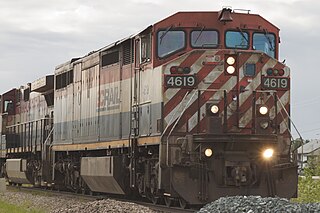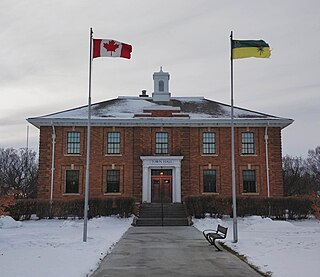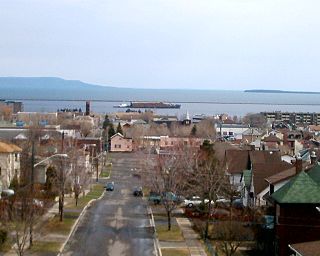
The Canadian Pacific Railway, also known simply as CPR or Canadian Pacific and formerly as CP Rail (1968–1996), is a Canadian Class I railway incorporated in 1881. The railway is owned by Canadian Pacific Kansas City Limited, known until 2023 as Canadian Pacific Railway Limited, which began operations as legal owner in a corporate restructuring in 2001.

The British Columbia Railway Company, commonly known as BC Rail, is a railway in the Canadian province of British Columbia.

Crowsnest Pass is a low mountain pass across the Continental Divide of the Canadian Rockies on the Alberta–British Columbia border.

A branch line is a secondary railway line which branches off a more important through route, usually a main line. A very short branch line may be called a spur line. Branch lines may serve one or more industries, or a city or town not located on a main line. Branch lines may also connect two or more main lines.

The Island Corridor, previously the Esquimalt & Nanaimo Railway, is a railway operation on Vancouver Island. It is owned by the Island Corridor Foundation, a registered charity. The railway line is 225 kilometres (140 mi) in length from Victoria to Courtenay, known as the Victoria Subdivision, with a branch line from Parksville to Port Alberni, known as the Port Alberni Subdivision, of 64 kilometres (40 mi), for a total 289 kilometres (180 mi) of mainline track. In 2006, the Island Corridor Foundation acquired the railway's ownership from RailAmerica and Canadian Pacific Railway.
Canadian Pacific Limited was created in 1971 to own properties formerly owned by Canadian Pacific Railway (CPR), a transportation and mining giant in Canada. In October 2001, CPR completed the corporate spin-offs of each of the remaining businesses it had not sold, including Canadian Pacific Railway Limited.

The Cape Breton and Central Nova Scotia Railway is a short line railway that operates in the Canadian province of Nova Scotia. CBNS operates of main line and associated spurs between Truro in the central part of the province to Point Tupper on Cape Breton Island.

Shaunavon is a town in southwest Saskatchewan. At the junction of Highways 37 and 13, it is 110 kilometres from Swift Current, 163 kilometres from the Alberta border, and 74 kilometres from the Montana border. Shaunavon was established in 1913 along the Canadian Pacific Railway line.
Robert Angus Bandeen was a Canadian businessman and former President and Chief Executive Officer of Canadian National Railways.
The Indiana Rail Road is a United States Class II railroad, originally operating over former Illinois Central Railroad trackage from Newton, Illinois, to Indianapolis, Indiana, a distance of 155 miles (249 km). This line, now known as the Indiana Rail Road's Indianapolis Subdivision, comprises most of the former IC/ICG line from Indianapolis to Effingham, Illinois; Illinois Central successor Canadian National Railway retains the portion from Newton to Effingham. INRD also owns a former Milwaukee Road line from Terre Haute, Indiana, to Burns City, Indiana, with trackage rights extending to Chicago, Illinois. INRD no longer serves Louisville, Kentucky, and the Port of Indiana on the Ohio River at Jeffersonville, Indiana, through a haulage agreement with the Louisville & Indiana Railroad (LIRC).
The North Western Coal and Navigation Company, also known as Alberta Railway and Coal Company or Alberta Railway and Irrigation Company, was a coal mining company formed in London, England in 1882 by Sir Alexander Tilloch Galt, one of Canada's Fathers of Confederation. As part of his vision for Canada, Galt was committed to finding industries that would bring settlers to the District of Alberta of the Northwest Territories. The company was founded to create a coal mining industry that could bring settlers to the Northwest Territories. It was based in Lethbridge, Alberta, with his son Elliott Torrance Galt, managing day-to-day operations. The company's superintendent was William Stafford. Money for this company came from a consortium of investors from Canada, England, and the United States.
OmniTRAX, Inc. is a transportation and transportation infrastructure holding company based in Denver, Colorado, in the United States. It primarily owns or operates railroads, with a network of 25 regional and shortline railroads in 12 U.S. states and three Canadian provinces. It is one of the largest privately owned railroad companies in the United States. The firm also invests in, develops, and operates ports, multimodal transportation terminals, and industrial parks.

Transport in Thunder Bay is essential to trade, which has always been the backbone of the economy, beginning with Fort Kaministiquia in 1717. When the area was first settled its many waterways were used by the voyagers and Coureur des bois to trade their goods.

The Moyie is a paddle steamer sternwheeler that operated on Kootenay Lake in British Columbia from 1898 until 1957.
The Columbia and Western Railway (C&W) was a historic, and initially narrow gauge, railway in southern British Columbia.

From 1886 to 1920, steamboats ran on the upper reaches of the Columbia and Kootenay in the Rocky Mountain Trench, in western North America. The circumstances of the rivers in the area, and the construction of transcontinental railways across the trench from east to west made steamboat navigation possible.
The Western Grain Transportation Act was a 1983 Canadian federal statute under which the formula for calculating a transport subsidy was modified. The subsidy, informally called the Crow Rate, Crow benefit or Crow subsidy, had been provided since 1897 by the Government of Canada to assist the rail transportation of specified grains and grain products to specified destinations within Canada for export. Since the producer paid only a portion of the freight rate, the Act had the effect of increasing the prices received by grain producers and paid by livestock producers on the prairies. The subsidy encouraged the movement of grain east and west to export shipping terminals.

The Manitoba Grain Act was an act passed by the federal government of Canada in 1900 to protect the interests of grain farmers against abuses by the grain storage and trading companies and the railways. Although well-intentioned the act was flawed, and a series of amendments were required before the more effective Canada Grain Act of 1912 was passed.
The history of the Canadian Pacific Railway dates back to 1873. Together with the Canadian Confederation, the creation of the Canadian Pacific Railway was a task originally undertaken as the "National Dream" by the Conservative government of Prime Minister John A. Macdonald. A key component of his National Policy, Macdonald was helped by Alexander Tilloch Galt, who was the owner of the North Western Coal and Navigation Company. British Columbia, a four-month sea voyage away from the East Coast, had insisted upon a land transport link to the East as a condition for joining Confederation, after initially requesting a wagon road.











